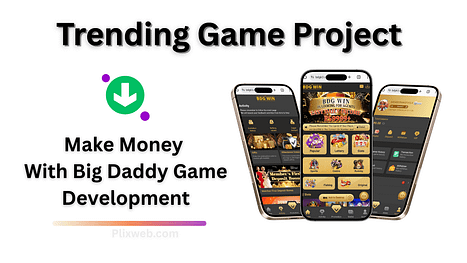From Concept to Launch: How to Develop a Big Daddy Game
The gaming industry is booming, and creating a unique, engaging game like Big Daddy can be a lucrative venture. Whether you’re an indie developer or a studio looking to build a Big Daddy game, this guide covers everything from concept to launch, including Big Daddy game development cost, features, revenue models, and more.
Big Daddy Game
From Concept to Launch: How to Develop a Big Daddy Game
 |
| Big Daddy Game |
1. Conceptualizing Your Big Daddy Game
Before diving into development, define your game’s core concept:
- Genre: Will it be an action-adventure, RPG, or survival horror game?
- Storyline: Develop a compelling narrative that keeps players engaged.
- Game Mechanics: Decide on combat systems, puzzles, or multiplayer features.
Before diving into development, define your game’s core concept:
- Genre: Will it be an action-adventure, RPG, or survival horror game?
- Storyline: Develop a compelling narrative that keeps players engaged.
- Game Mechanics: Decide on combat systems, puzzles, or multiplayer features.
2. Key Features of a Big Daddy Game
To make your game stand out, include these Big Daddy game features:
- Immersive Environments: Detailed, atmospheric worlds.
- Unique Characters: Memorable protagonists and antagonists.
- Advanced AI: Smart enemy behavior for challenging gameplay.
- Customization: Weapon upgrades, skill trees, or character personalization.
- Multiplayer Modes (Optional): Co-op or PvP for extended replayability.
To make your game stand out, include these Big Daddy game features:
- Immersive Environments: Detailed, atmospheric worlds.
- Unique Characters: Memorable protagonists and antagonists.
- Advanced AI: Smart enemy behavior for challenging gameplay.
- Customization: Weapon upgrades, skill trees, or character personalization.
- Multiplayer Modes (Optional): Co-op or PvP for extended replayability.
3. Big Daddy Game Development Process
Step 1: Pre-Production
- Create concept art, storyboards, and a game design document (GDD).
- Assemble a team (developers, artists, sound designers).
- Create concept art, storyboards, and a game design document (GDD).
- Assemble a team (developers, artists, sound designers).
Step 2: Prototyping & Big Daddy Game Demo
- Develop a Big Daddy game demo to test core mechanics.
- Gather feedback and refine gameplay.
- Develop a Big Daddy game demo to test core mechanics.
- Gather feedback and refine gameplay.
Step 3: Full-Scale Development
- Build levels, integrate assets, and program AI.
- Optimize performance for different platforms (PC, console, mobile).
- Build levels, integrate assets, and program AI.
- Optimize performance for different platforms (PC, console, mobile).
Step 4: Testing & Quality Assurance
- Fix bugs, balance difficulty, and ensure smooth performance.
- Fix bugs, balance difficulty, and ensure smooth performance.
Step 5: Launch & Marketing
- Release a custom Big Daddy game launch with trailers and social media campaigns.
- Consider early access to build a player base.
- Release a custom Big Daddy game launch with trailers and social media campaigns.
- Consider early access to build a player base.
4. Big Daddy Game Development Cost
The Big Daddy game development cost varies based on:
- Team Size: Indie vs. AAA studio.
- Game Complexity: 2D vs. 3D, open-world vs. linear.
- Platforms: Developing for multiple platforms increases costs.
Estimated costs:
- Indie Game: 50,000−50,000−200,000
- Mid-Range Game: 200,000−200,000−1M
- AAA Game: 1M−1M−50M+
The Big Daddy game development cost varies based on:
- Team Size: Indie vs. AAA studio.
- Game Complexity: 2D vs. 3D, open-world vs. linear.
- Platforms: Developing for multiple platforms increases costs.
Estimated costs:
- Indie Game: 50,000−50,000−200,000
- Mid-Range Game: 200,000−200,000−1M
- AAA Game: 1M−1M−50M+
5. Big Daddy Game Revenue Models
To monetize your game, consider these Big Daddy game revenue models:
- Premium Pricing: One-time purchase.
- Free-to-Play (F2P): In-game purchases (cosmetics, power-ups).
- Subscription Model: Monthly access fees.
- DLCs & Expansions: Additional content post-launch.
To monetize your game, consider these Big Daddy game revenue models:
- Premium Pricing: One-time purchase.
- Free-to-Play (F2P): In-game purchases (cosmetics, power-ups).
- Subscription Model: Monthly access fees.
- DLCs & Expansions: Additional content post-launch.
6. Hiring a Big Daddy Game Development Company
If you lack expertise, partner with a Big Daddy game development company that offers:
- End-to-end Big Daddy game solutions
- Custom Big Daddy game services (art, programming, QA)
- Post-launch support & updates
If you lack expertise, partner with a Big Daddy game development company that offers:
- End-to-end Big Daddy game solutions
- Custom Big Daddy game services (art, programming, QA)
- Post-launch support & updates
7. Post-Launch Strategies
- Release updates and expansions to retain players.
- Engage with the community through forums and social media.
- Analyze player data to improve future updates.
- Release updates and expansions to retain players.
- Engage with the community through forums and social media.
- Analyze player data to improve future updates.
Conclusion
Developing a Big Daddy game requires careful planning, creativity, and investment. By following this roadmap — from concept to custom Big Daddy game launch — you can create a successful title that captivates players and generates revenue.
Ready to create a Big Daddy game? Partner with a professional Big Daddy game development team today and bring your vision to life!
Developing a Big Daddy game requires careful planning, creativity, and investment. By following this roadmap — from concept to custom Big Daddy game launch — you can create a successful title that captivates players and generates revenue.
Ready to create a Big Daddy game? Partner with a professional Big Daddy game development team today and bring your vision to life!
%20(1).png)
.png)
No comments:
Post a Comment